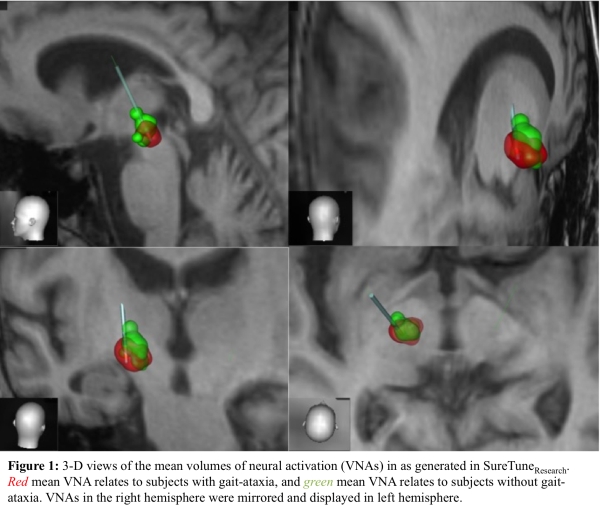Session Information
Date: Monday, June 20, 2016
Session Title: Surgical Therapy
Session Time: 12:30pm-2:00pm
Objective: We aimed to disentangle a putative role of bilateral thalamic DBS in developing gait-ataxia in subjects with ET.
Background: In ET patients with DBS, progressive cerebellar symptoms may appear over time and are difficult to amend by acute changes in neurostimulation parameters. The pathophysiology is still unclear, but an altered cerebello-thalamic outflow induced by stimulation can be foreseen.
Methods: Ten subjects with ET and effective DBS (median tremor reduction 73%) were divided in two groups according to the presence of severe gait-ataxia. Volumes of Neuron Activation (VNAs) were computed for each lead in subject’s related MRI space. Images were registered to a common patient average MRI (PAM) of the ventral thalamus and subthalamic area. The median VNA was calculated for each group by aggregating all the relevant VNAs. We also measured resting-state brain metabolic activity with two consequent PET with 18F-fluorodeoxyglucose (FDG) performed in stimulation-on and -off state (72 h).
Results: The median VNA inducing ataxia (43mm3) was located inferior and posterior-medial towards non-ataxic subjects (43mm3). Stereotactic hotspot of the mean VNA of the ataxia (lateral:11.9/posterior:5.1/superior:-0.9) and control group (lateral:12.8/posterior:4.4/superior:2.1) was respectively different (AC-PC based in mm). Ataxic subjects showed an increased FDG uptake selectively in the cerebellar nodule (T=6.40,p<0.01). Of note, at 72h stimulation-off, gait ataxia dramatically improved
Conclusions: Our study suggests that progressive gait-ataxia in ET subjects under chronic DBS is a reversible cerebellar symptom induced by posteromedial current spread in the (sub-)thalamic area. The increased FDG uptake in the cerebellar nodule further supports an antidromic effect of thalamic DBS on the outflow pathways of the vestibulocerebellum. This finding is not consistent with an antidromic activation of dentate-thalamic fibers -the presumed target of effective thalamic DBS-, which should result in metabolic changes of cerebellar hemispheres. We speculate that inadvertent stimulation of the ascending limb of the uncinate tract could underlie this long-term adverse effect of DBS. The ascending limb of the uncinate tract (part of the fastigiobulbar fibers) projects from the fastigial nucleus to ventolateral/intralaminar thalamic nuclei and subserves vestibulocerebellar functions.
To cite this abstract in AMA style:
M.M. Reich, J. Brumberg, N. Pozzi, M. Åström, R. Nijlunsing, T. Musacchio, F. Steigerwald, G. Marotta, A. Buck, J. Volkmann, I.U. Isaias. Ataxic gait in subjects with essential tremor and thalamic neurostimulation is caused by posteromedial current spread in the (sub)thalamic area [abstract]. Mov Disord. 2016; 31 (suppl 2). https://www.mdsabstracts.org/abstract/ataxic-gait-in-subjects-with-essential-tremor-and-thalamic-neurostimulation-is-caused-by-posteromedial-current-spread-in-the-subthalamic-area/. Accessed December 13, 2025.« Back to 2016 International Congress
MDS Abstracts - https://www.mdsabstracts.org/abstract/ataxic-gait-in-subjects-with-essential-tremor-and-thalamic-neurostimulation-is-caused-by-posteromedial-current-spread-in-the-subthalamic-area/
